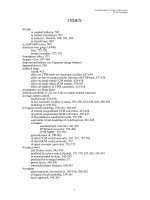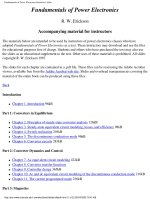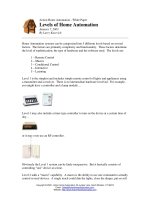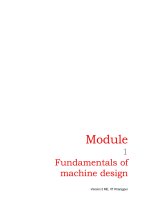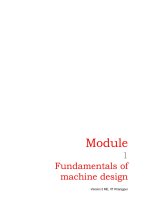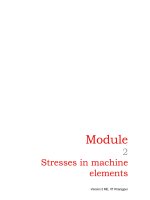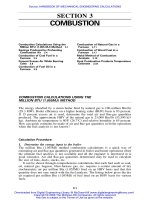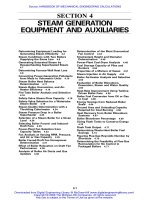Tài liệu Fundamentals of Mechanical Ventilation doc
Bạn đang xem bản rút gọn của tài liệu. Xem và tải ngay bản đầy đủ của tài liệu tại đây (4.37 MB, 312 trang )
Fundamentals of
M
M
e
e
c
c
h
h
a
a
n
n
i
i
c
c
a
a
l
l
V
V
e
e
n
n
t
t
i
i
l
l
a
a
t
t
i
i
o
o
n
n
A short course on the
theory and application
of mechanical ventilators
Robert L. Chatburn, BS, RRT-NPS, FAARC
Director
Respiratory Care Department
University Hospitals of Cleveland
Associate Professor
Department of Pediatrics
Case Western Reserve University
Cleveland, Ohio
Mandu Press Ltd.
Cleveland Heights, Ohio
Published by:
Mandu Press Ltd.
PO Box 18284
Cleveland Heights, OH 44118-0284
All rights reserved. This book, or any parts thereof, may not be
used or reproduced by any means, electronic or mechanical,
including photocopying, recording or by any information storage
and retrieval system, without written permission from the publisher,
except for the inclusion of brief quotations in a review.
First Edition
Copyright 2003 by Robert L. Chatburn
Library of Congress Control Number: 2003103281
ISBN, printed edition: 0-9729438-2-X
ISBN, PDF edition: 0-9729438-3-8
First printing: 2003
Care has been taken to confirm the accuracy of the information
presented and to describe generally accepted practices. However, the
author and publisher are not responsible for errors or omissions or
for any consequences from application of the information in this
book and make no warranty, express or implied, with respect to the
contents of the publication.
Table of Contents
1. INTRODUCTION TO VENTILATION 1
Self Assessment Questions 4
Definitions 4
True or False 4
Multiple Choice 5
Key Ideas 6
2. INTRODUCTION TO VENTILATORS 7
Types of Ventilators 7
Conventional Ventilators 8
High Frequency Ventilators 8
Patient-Ventilator Interface 9
Positive Pressure Ventilators 9
Negative Pressure Ventilators 9
Power Source 10
Positive Pressure Ventilators 10
Negative Pressure Ventilators 10
Control System 10
Patient Monitoring System 11
Alarms 11
Graphic Displays 12
Self Assessment Questions 14
Definitions 14
True or False 15
Multiple Choice 15
Key Ideas 16
3. HOW VENTILATORS WORK 17
Input Power 18
Power Transmission and Conversion 18
Control System 19
The Basic Model of Breathing (Equation of Motion) 19
Control Circuit 25
Control Variables 26
Phase Variables 28
Modes of Ventilation 41
Breathing Pattern 42
Control Type 52
Control Strategy 57
The Complete Specification 58
Alarm Systems 61
Input Power Alarms 64
Control Circuit Alarms 64
Output Alarms 65
Self Assessment Questions 67
Definitions 67
True or False 69
Multiple Choice 71
Key Ideas 80
4. HOW TO USE MODES OF VENTILATION 82
Volume Control vs Pressure Control 82
The Time Constant 90
Continuous Mandatory Ventilation (CMV) 94
Volume Control 95
Pressure Control 98
Dual Control 102
Intermittent Mandatory Ventilation (IMV) 104
Volume Control 105
Pressure Control 106
Dual Control 107
Continuous Spontaneous Ventilation (CSV) 108
Pressure Control 108
Dual Control 113
Self Assessment Questions 114
Definitions 114
True or False 114
Multiple Choice 116
Key Ideas 119
5. HOW TO READ GRAPHIC DISPLAYS 121
Rapid Interpretation of Graphic Displays 121
Waveform Display Basics 122
Volume Controlled Ventilation 123
Pressure Controlled Ventilation 128
Volume Controlled vs. Pressure Controlled Ventilation 134
Effects of the Patient Circuit 138
Idealized Waveform Displays 142
Pressure 144
Volume 145
Flow 146
Recognizing Modes 147
How to Detect problems 165
Loop Displays 175
Pressure-Volume Loop 175
Flow-Volume Loop 185
Calculated Parameters 190
Mean Airway Pressure 190
Leak 192
Calculating Respiratory System Mechanics: Static vs Dynamic
192
Compliance 194
Dynamic Characteristic 196
Resistance 197
Time Constant 199
Pressure-Time Product 200
Occlusion Pressure (P
0.1
) 201
Rapid Shallow Breathing Index 201
Inspiratory Force 202
AutoPEEP 202
Work of Breathing 203
Self Assessment Questions 211
Definitions 211
True or False 211
Multiple Choice 213
Key Ideas 218
APPENDIX I: ANSWERS TO QUESTIONS 220
Chapter 1: Introduction to Ventilation 220
Definitions 220
True or False 220
Multiple Choice 220
Key ideas 221
Chapter 2: Introduction to Ventilators 221
Definitions 221
True or False 222
Multiple Choice 223
Key Ideas 223
Chapter 3: How Ventilators Work 223
Definitions 223
True or False 229
Multiple Choice 230
Key Ideas 232
Review and Consider 232
Chapter 4: How to Use Modes of Ventilation 241
Definitions 241
True or False 242
Multiple Choice 244
Key ideas 244
Review and Consider 245
Chapter 5: How to Read Graphic Displays 253
Definitions 253
True or False 255
Multiple Choice 256
Key ideas 257
Review and Consider 258
APPENDIX II: GLOSSARY 273
APPENDIX III: MODE CONCORDANCE 283
Table of Figures
Figure 2-1. A display of pressure, volume, and flow waveforms
during mechanical ventilation. 13
Figure 2-2. Two types of loops commonly used to assess patient-
ventilator interactions 13
Figure 3-1. Models of the ventilatory system. P = pressure. Note
that compliance = 1/elastance. Note that intertance is ignored
in this model, as it is usually insignificant 20
Figure 3-2. Multi-compartment model of the respiratory system
connected to a ventilator using electronic analogs. Note that
the right and left lungs are modeled as separate series
connections of a resistance and compliance. However, the two
lungs are connected in parallel. The patient circuit resistance is
in series with the endotracheal tube. The patient circuit
compliance is in parallel with the respiratory system. The chest
wall compliance is in series with that of the lungs. The
function of the exhalation manifold can be shown by adding a
switch that alternately connects the patient and patient circuit
to the positive pole of the ventilator (inspiration) or to ground
(the negative pole, for expiration). Note that inertance,
modeled as an electrical inductor, is ignored in this model as it
is usually negligible. 23
Figure 3-3. Series and parallel connections using electronic analogs.
24
Figure 3-4. The criteria for determining the control variable during
mechanical ventilation 26
Figure 3-5. Time intervals of interest during expiration 29
Figure 3-6. The importance of distinguishing between the terms
limit and cycle. A. Inspiration is pressure limited and time
cycled. B. Flow is limited but volume is not, and inspiration is
volume cycled. C. Both volume and flow are limited and
inspiration is time cycled. 32
Figure 3-7. Time intervals of interest during inspiration 34
Figure 3-8. Airway pressure effects with different expiratory
pressure devices. A. The water-seal device does not maintain
constant pressure and does not allow the patient to inhale,
acting like a one-way valve; B. A flow restrictor does not
maintain constant pressure but allows limited flow in both
directions; C. An electronic demand valve maintains nearly
constant pressure and allows unrestricted inspiratory and
expiratory flow 39
Figure 3-9. Operational logic for dual control between breaths.
The cycle variable can be time as shown or flow depending on
the specific mode and ventilator. 44
Figure 3-10. Operational logic for dual control within breaths as
implemented in the Pressure Augment mode on the Bear 1000
ventilator 45
Figure 3-11. Operational logic for dual control within breaths as
implemented using P
max
on the Dräger Evita 4 ventilator 47
Figure 3-12. Schematic diagram of a closed loop or feedback
control system. The + and – signs indicate that the input
setting is compared to the feedback signal and if there is a
difference, an error signal is sent to the controller to adjust the
output until the difference is zero 53
Figure 4-1. Influence diagram showing the relation among the key
variables during volume controlled mechanical ventilation 83
Figure 4-2. Influence diagram showing the relation among the key
variables during pressure controlled mechanical ventilation.
The shaded circles show variables that are not set on the
ventilator 84
Figure 4-3. Radford nomogram for determining appropriate
settings for volume controlled ventilation of patients with
normal lungs. Patients with paremchymal lung disease should
be ventilated with tidal volumes no larger than 6 mL/kg 85
Figure 4-4. Comparison of volume control using a constant
inspiratory flow (left) with pressure control using a constant
inspiratory pressure (right). Shaded areas show pressure due to
resistance. Unshaded areas show pressure due to compliance.
The dashed line shows mean airway pressure. Note that lung
volume and lung pressure have the same waveform shape 88
Figure 4-5. Graph illustrating inspiratory and expiratory time
constants 92
Figure 5-1. Pressure, volume and flow waveforms for different
physical models during volume controlled ventilation. A
Waveforms for a model with resistance only showing sudden
initial rise in pressure at the start of inspiration and then a
constant pressure to the end. B Waveforms for a model with
elastance only showing a constant rise in pressure from
baseline to peak inspiratory pressure. C Waveforms for a
model with resistance and elastance, representing the
respiratory system. Pressure rises suddenly at the start of
inspiration due to resistance and then increases steadily to
peak inspiratory pressure due to elastance. 124
Figure 5-2. Effects of changing respiratory system mechanics on
airway pressure during volume controlled ventilation. Dashed
line shows original waveform before the change A Increased
resistance causes an increase in the initial pressure at the start
of inspiration and a higher peak inspiratory pressure and
higher mean pressure. B An increase in elastance (decrease in
compliance) causes no change in initial pressure but a higher
peak inspiratory pressure and higher mean pressure. C A
decrease in elastance (increase in compliance) causes no
change in initial pressure but a lower peak inspiratory pressure
and lower mean pressure 127
Figure 5- 3. Pressure, volume and flow waveforms for different
physical models during pressure controlled ventilation. A
Waveforms for a model with resistance only. B Waveforms
for a model with elastance only. C Waveforms for a model
with resistance and elastance, representing the respiratory
system. Note that like Figure 5-1, the height of the pressure
waveform at each moment is determined by the height of the
flow waveform added to the height of the volume waveform.
129
Figure 5-4. Effects of changing respiratory system mechanics on
airway pressure during pressure controlled ventilation. A
Waveforms before any changes. B Increased resistance causes
a decrease in peak inspiratory flow, a lower tidal volume, and a
longer time constant. Note that inspiration is time cycled
before flow decays to zero. C An increase in elastance
(decrease in compliance) causes no change in peak inspiratory
flow but decreases tidal volume and decreases the time
constant 133
Figure 5-5. Volume control compared to pressure control at the
same tidal volume. On the pressure waveforms the dotted
lines show that peak inspiratory pressure is higher for volume
control. On the volume/lung pressure waveforms, the dotted
lines show (a) peak lung pressure is the same for both modes
and (b) that pressure control results in a larger volume at mid
inspiration 135
Figure 5-6. Waveforms associated with an inspiratory hold during
volume controlled ventilation. Notice that inspiratory flow
time is less than inspiratory time and flow goes to zero during
the inspiratory pause time while pressure drops from peak to
plateau. 137
Figure 5-7. Theoretical pressure, volume, and flow waveforms for
the same tidal volume and inspiratory time. (A) pressure
control with a rectangular pressure waveform; (B) flow
control with a rectangular flow waveform; (C) flow control
with an ascending ramp flow waveform; (D) flow control with
a descending ramp flow waveform; (E) flow control with a
sinusoidal flow waveform. Short dashed lines represent mean
inspiratory pressure. Long dashed lines show mean airway
pressure 143
Figure 5-8. Two methods of calculating mean airway pressure 192
Figure 5-9. Static compliance measurement. 194
Figure 5-10. The least squares regression method for calculating
compliance. The linear regression line is fit to the data by a
mathematical procedure that minimizes the sum of the
squared vertical distances between the data points and the
line 195
Figure 5-11. Calculation of the dynamic characteristic 197
Figure 5-12. Static method of calculating resistance 198
Figure 5-13. Calculation of P
0.1
on the Drager Evita 4 ventilator.
PTP = pressure-time product 201
Figure 5-14. AutoPEEP and the volume of trapped gas measured
during an expiratory hold maneuver. The airway is occluded at
the point where the next breath would normally be triggered.
During the brief occlusion period, the lung pressure
equilibrates with the patient circuit to give a total PEEP
reading. When the occlusion is released, the volume exhaled is
the trapped gas 203
Figure 5-15. Work of breathing during mechanical ventilation. The
patient does work on the ventilator as he inspires a small
volume from the patient circuit and drops the airway pressure
enough to trigger inspiration. The ventilator does work on the
patient as airway pressure rises above baseline. 204
Table of Tables
Table 3-1. Mode classification scheme 42
Table 3-2. Breathing patterns 51
Table 3-3. Control types, descriptions, and examples 56
Table 3-4. Examples of how to describe simple, moderately
complex and complex modes using the classification scheme
shown in Table 3-1 60
Table 3-5. Classification of Desirable Ventilator Alarms 63
Table 4-1. Equations relating the variables in shown in Figures 4-1
and 4-3. 86
- i -
Preface
Find a better way to educate students than the current books offer. If you can’t
improve on what’s available, what’s the point?
Earl Babbbie
Chapman University
This book is about how ventilators work. It shows you how to think
about ventilators, when to use various modes, and how to know if
they are doing what you expect. This book does not say much about
how to use ventilators in various clinical situations or how to liberate
patients from the machine. Mechanical ventilation is still more of an
art than a science. This book leads you to expertise with the theory
and tools of that art. You will then be able to make the best use of
other books and actual clinical experience.
There are 18 books devoted to mechanical ventilation on my
bookshelf. They are all well written by noted experts in the field.
Some are commonly used in colleges while others have fallen into
obscurity. Yet, in my opinion, they all have the same limitation; they
devote only a small fraction of their pages to how ventilators actually
work. Most of their emphasis is on how ventilators are used to
support various disease states, the physiological effects of
mechanical ventilation, weaning, and adjuncts like artificial airways
and humidifiers. This book is different.
The reason I made this book different may be clarified by analogy.
Suppose you wanted to learn how to play the guitar. You go to the
library, but all you can find are books that give you a few pages
describing what different guitars look like and all the fancy names
and features their manufacturers have made up. There may be a little
information about how many strings they have and even what notes
and chords can be played. Unfortunately, many of the books use
words with apparently conflicting or obscure meanings. There is no
consistency and no music theory. They all devote most of their
content to a wide variety of song scores, assuming the few pages of
introduction to the instrument will allow you to play them. How
well do you think you would learn to play the guitar from these
books? If you have ever actually tried it, you would see the difficulty.
That approach works for a simple instrument like a harmonica, but
it does not work well for a complex device like a mechanical
ventilator. In a similar fashion, we don’t let our teenagers drive cars
after simply pointing out the controls on the dashboard; they have
to sit through weeks of theory before ever getting behind the wheel.
- ii -
You can kill or injure somebody with a ventilator just as fast as you
can with a car.
Certainly there is a great need for understanding the physiological
effect of mechanical ventilation. But most authors seem to put the
cart before the horse. In this book, I have tried to present the
underlying concepts of mechanical ventilation from the perspective
of the ventilator. All terminology has been clearly defined in a way
that develops a consistent theoretical framework for understanding
how ventilators are designed to operate. There is one chapter
devoted to how to use ventilators, but it is written from the
perspective of what the ventilator can do and how you should think
about the options rather than from what physiological problem the
patient may have. There is also a chapter devoted to monitoring the
ventilator-patient interface through waveform analysis, a key feature
on modern ventilators. In short, this book will teach you how to
think about ventilators themselves. It teaches you how to master the
instrument. That way you are better prepared to orchestrate patient
care. Only after thoroughly understanding what ventilators do will
you be in a position to appreciate your own clinical experience and
that of other expert authors.
The unique approach of this book makes it valuable not only to
health care workers but to those individuals who must communicate
with clinicians. This includes everyone from the design engineer to
the marketing executive to the sales force and clinical specialists.
Indeed, since manufacturers provide most of the education on
mechanical ventilation, the most benefit may come from advancing
their employees’ level of understanding.
- iii -
How to Use This Book
This book may be read on a variety of levels depending on your
educational needs and your professional background. Look at the
different approaches to reading and see what is most appropriate for
you.
Basic Familiarity: This level is appropriate for people not directly
responsible for managing ventilators in an intensive care
environment. This may include healthcare personnel such as nurses,
patients on home care ventilators, or those not directly involved at
the bedside such as administrators or ventilator sales personnel.
Study the first two chapters and the section on alarms in Chapter 3.
Skim the others for areas of interest, paying attention to the figures
in Chapter 5.
Comprehensive Understanding: Respiratory care students should achieve
this level along with physicians and nurses who are responsible for
ventilator management. Some sales personnel may wish to
understand ventilators at this level in order to converse easily with
those who buy and use them. Study all the chapters, but skip the
“Extra for Experts” sections. Pay attention to the “Key Idea”
paragraphs and the definitions in the Glossary. Make sure you
understand Chapter 5.
Subject Mastery: This level is desirable for anyone who is in a position
to teach mechanical ventilation and particularly for those who are
involved with research on the subject. All material in the book
should be understood, including the “Extra for Experts” sections. A
person at this level should be able to answer all the questions and
derive all the equations used throughout.
Of course, these levels are only suggestions and you will
undoubtedly modify them for your own use.
- iv -
Acknowledgement
The central ideas of this text came from two seminal papers I
published in Respiratory Care, the official scientific journal of the
American Association for Respiratory Care. The first was published
in 1991, and introduced a new classification system for mechanical
ventilators (Respir Care 1991:36(10):1123-1155). It was republished
the next year as a part of the Journal’s Consensus Conference on the
Essentials of Mechanical Ventilators (Respir Care 1992:37(9):1009-
1025). Eventually, those papers became the basis for book chapters
on ventilator design in every major respiratory care textbook:
• Tobin MJ. Principles and Practice of Mechanical Ventilation,
1994. McGraw-Hill.
• Branson RD, Hess DR, Chatburn RL. Respiratory Care
Equipment, 1
st
and 2
nd
editions, 1995 & 1999. Lippincott.
• White GC. Equipment for Respiratory Care 2
nd
edition,
1996, Delmar.
• Hess DR, Kacmarek RM. Essentials of Mechanical Ventilation,
1996. McGraw-Hill.
• Pilbeam SP. Mechanical Ventilation. Physiological and
Clinical Applications, 3
rd
edition, 1998. Mosby.
• Scanlan CL, Wilkins RL, Stoller JK. Egan’s Fundamentals of
Respiratory Care 7
th
edition, 1999. Mosby.
• Branson RD. MacIntyre NR. Mechanical Ventilation, 2001.
WB Saunders.
• Wyka KA, Mathews PJ, Clark WF. Foundations of Respiratory
Care, 2002. Delmar.
• Hess DR, MacIntyre NR, Mishoe SC, Galvin WF, Adams
WB, Saposnick AB. Respiratory Care. Principles and Practice,
2002. Saunders.
In 2001, my coauthor, Dr. Frank Primiano Jr., and I introduced a
new system for classifying modes of ventilation (Respir Care 2001;
46(6):604-621), tying in with the principles established in the earlier
publications. That paper received the Dr. Allen DeVilbiss
Technology Paper Award for best paper of the year at the 2001
International Respiratory Care Congress. Only the last book listed
above has that information.
In this book you are getting the latest information, undiluted,
uninterpreted, from the original author.
- v -
Dedication
It’s an endless, glamorless, thankless job.
But somebody’s got to do it.
Sergeant Joe Friday
LAPD
This book is dedicated to everyone who has ever tried to teach the
subject of mechanical ventilation. It has always been a daunting task,
given the lack of a unified lexicon, complex technological advances,
and an endless stream of clinical studies and conflicting opinions.
Yet, here and there, lone educators stay up endless nights writing
textbooks and lectures; intrepid clinical specialists fly red-eye
specials around the globe to eager but clueless audiences; sales
personnel valiantly argue their cause; and frustrated engineers try to
communicate with inventive clinical researchers. Much of this effort
is expended simply for the love of the subject. Keep up the good
work; you benefit countless lives.
- 1 -
1
1
.
.
I
I
N
N
T
T
R
R
O
O
D
D
U
U
C
C
T
T
I
I
O
O
N
N
T
T
O
O
V
V
E
E
N
N
T
T
I
I
L
L
A
A
T
T
I
I
O
O
N
N
D
uring breathing, a volume of air is inhaled through the
airways (mouth and/or nose, pharynx, larynx, trachea,
and bronchial tree) into millions of tiny gas exchange sacs
(the alveoli) deep within the lungs. There it mixes with the
carbon dioxide-rich gas coming from the blood. It is then exhaled
back through the same airways to the atmosphere. Normally this
cyclic pattern repeats at a breathing rate, or frequency, of about 12
breaths a minute (breaths/min) when we are at rest (a higher resting
rate for infants and children). The breathing rate increases when we
exercise or become excited.
1
Gas exchange is the function of the lungs that is required to supply
oxygen to the blood for distribution to the cells of the body, and to
remove carbon dioxide from the blood that the blood has collected
from the cells of the body. Gas exchange in the lungs occurs only in
the smallest airways and the alveoli. It does not take place in the
airways (conducting airways) that carry the gas from the atmosphere
to these terminal regions. The size (volume) of these conducting
airways is called the anatomical dead space because it does not
participate directly in gas exchange between the gas space in the
lungs and the blood. Gas is carried through the conducting airways
by a process called "convection". Gas is exchanged between the
pulmonary gas space and the blood by a process called "diffusion".
One of the major factors determining whether breathing
is producing enough gas exchange to keep a person alive
is the ventilation the breathing is producing. Ventilation
(usually referred to as minute ventilation) is expressed as
the volume of gas entering, or leaving, the lungs in a
given amount of time. It can be calculated by multiplying
the volume of gas, either inhaled or exhaled during a
breath (called the tidal volume), times the breathing rate
(for example: 0.5 Liters x 12 breaths/min = 6 L/min).
1
This section is adapted from: Primiano FP Jr, Chatburn RL. What is a ventilator?
Part I. www.VentWorld.com; 2001.
Mechanical Ventilation
- 2 -
The level of ventilation can be monitored by measuring
the amount of carbon dioxide in the blood. For a given
level of carbon dioxide produced by the body, the
amount in the blood is inversely proportional to the level
of ventilation.
Therefore, if we were to develop a machine to help a person
breathe, or to take over his or her breathing altogether, it would
have to be able to produce a tidal volume and a breathing rate
which, when multiplied together, produce enough ventilation, but
not too much ventilation, to supply the gas exchange needs of the
body. During normal breathing the body selects a combination of a
tidal volume that is large enough to clear the dead space and add
fresh gas to the alveoli, and a breathing rate that assures the correct
amount of ventilation is produced. However, as it turns out, it is
possible, using specialized equipment, to keep a person alive with
breathing rates that range from zero (steady flow into and out of the
lungs) up to frequencies in the 100's of breaths per minute. Over
this frequency range, convection and diffusion take part to a greater
or lesser extent in distributing the inhaled gas within the lungs. As
the frequency is increased, the tidal volume that produces the
required ventilation gets smaller and smaller.
There are two sets of forces that can cause the lungs and chest wall
to expand: the forces produced when the muscles of respiration
(diaphragm, inspiratory intercostal, and accessory muscles) contract,
and the force produced by the difference between the pressure at
the airway opening (mouth and nose) and the pressure on the outer
surface of the chest wall. Normally, the respiratory muscles do the
work needed to expand the chest wall, decreasing the pressure on
the outside of the lungs so that they expand, which in turn enlarges
the air space within the lungs, and draws air into the lungs. The
difference between the pressure at the airway opening and the
pressure on the chest wall surface does not play a role in this activity
under normal circumstances. This is because both of these locations
are exposed to the same pressure (atmospheric), so this difference is
zero. However, when the respiratory muscles are unable to do the
work required for ventilation, either or both of these two pressures
can be manipulated to produce breathing movements, using a
mechanical ventilator.
It is not difficult to visualize that, if the pressure at the airway
opening (the mouth and nose or artificial airway opening) of an
individual were increased while the pressure surrounding the rest of
1. Introduction to Ventilation
- 3 -
the person's body remained at atmospheric, the person's chest
would expand as air is literally forced into the lungs. Likewise, if the
pressure on the person's body surface were lowered as the pressure
at the person's open mouth and nose remained at atmospheric, then
again the pressure at the mouth would be greater than that on the
body surface and air would be forced into the lungs.
Thus, we have two approaches that can be used to
mechanically ventilate the lungs: apply positive pressure
(relative to atmospheric) to the airway opening - devices
that do this are called positive pressure ventilators; or,
apply negative pressure (relative to atmospheric) to the
body surface (at least the rib cage and abdomen) - such
devices are called negative pressure ventilators.
Sometimes positive airway pressure is applied to a patient’s airway
opening without the intent to ventilate but merely to maintain a
normal lung volume. Originally, devices were designed to present
resistance to expiratory flow, and hence provide positive pressure
throughout expiration. The pressure at end expiration was called
positive end expiratory pressure or PEEP. The problem with these
early devices was that the patient had to inhale with enough force to
drop the airway pressure through the PEEP level to below
atmospheric pressure before inspiratory flow would begin. This
often increased the work of breathing to intolerable levels. Newer
devices were designed to avoid this problem. The key was to design
the device so that the patient could inspire by dropping the pressure
just below the PEEP level, rather than all the way to atmospheric
pressure. As a result, the pressure in the patient’s lungs remained
positive (above atmospheric) throughout the breathing cycle. Thus,
the new procedure was called continuous positive airway pressure or
CPAP. Almost all current ventilators provide CPAP rather than
PEEP. There are also devices that just produce CPAP for patients
that are breathing without a ventilator.
As time passed, people forgot the historic reasons for the distinction
between PEEP and CPAP. The original PEEP therapy is now called
“positive airway pressure”, PAP, and is used to help patients (who
are not connected to mechanical ventilators) to mobilize airway
secretions and reverse atelectasis. Currently, the term PEEP is
applied to the continuous positive airway pressure provided during
assisted ventilation by a mechanical ventilator. Assisted ventilation
means simply that the ventilator helps the patient with the timing
and/or work of inspiration. The term CPAP is usually applied to
Mechanical Ventilation
- 4 -
continuous positive airway pressure provided while the patient
breathes unassisted, such as for infants with respiratory distress
syndrome after extubation or adults with sleep apnea.
It is important to remember that CPAP and PEEP themselves are
not forms of assisted ventilation, in the sense that they do not
supply any of the work of breathing. They may, however, make it
easier for the patient to breathe by lowering airway resistance or
increasing lung compliance.
Self Assessment Questions
Definitions
Explain the meaning of the following terms:
• Anatomical dead space
• Minute ventilation
• Tidal volume
• PEEP
• CPAP
True or False
1. Gas exchange is the function of the lungs that is required
to supply oxygen to the blood for distribution to the cells
of the body, and to remove carbon dioxide from the blood
that the blood has collected from the cells of the body.
2. Gas exchange occurs in all the conducting airways and the
alveoli.
3. Minute ventilation is calculated as the product of tidal
volume and breathing rate.
4. The unit of measurement for minute ventilation is liters.
5. It is possible to keep a person alive with breathing rates
that range from zero (steady flow into and out of the lungs)
up to frequencies in the 100's of breaths per minute.
1. Introduction to Ventilation
- 5 -
Multiple Choice
1. The forces that expand the lungs and chest wall during
inspiration are:
a. The forces produced when the muscles of
respiration (diaphragm, inspiratory intercostal,
and accessory muscles) contract.
b. Positive end expiratory pressure (PEEP).
c. The force produced by the difference between
the pressure at the airway opening (mouth and
nose) and the pressure on the outer surface of the
chest wall.
d. Both a and c.
2. In order to generate an inspiration, the following condition
must be present:
a. Lung pressure must be higher than pressure at the
airway opening.
b. Airway pressure must be higher than body surface
pressure.
c. Body surface pressure must be higher than airway
pressure.
d. Pleural pressure must be lower than body surface
pressure.
3. In order to generate an expiration, the following condition
must be present:
a. Lung pressure must be higher than pressure at the
airway opening.
b. Pressure at the airway opening must be higher
than body surface pressure.
c. Body surface pressure must be higher than
pressure at the airway opening.
d. Body surface pressure must be lower than lung
pressure.
Mechanical Ventilation
- 6 -
Key Ideas
1. What two variables determine whether breathing is
producing enough gas exchange to keep a person alive?
2. Explain how the level of ventilation can be monitored by
measuring carbon dioxide in the blood. Why not just
measure tidal volume and frequency?
3. Describe the difference between positive pressure
ventilators and negative pressure ventilators.
- 7 -
2
2
.
.
I
I
N
N
T
T
R
R
O
O
D
D
U
U
C
C
T
T
I
I
O
O
N
N
T
T
O
O
V
V
E
E
N
N
T
T
I
I
L
L
A
A
T
T
O
O
R
R
S
S
A
mechanical ventilator is an automatic machine designed
to provide all or part of the work the body must produce to
move gas into and out of the lungs. The act of moving air
into and out of the lungs is called breathing, or, more
formally, ventilation.
The simplest mechanical device we could devise to assist a person's
breathing would be a hand-driven, syringe-type pump that is fitted
to the person's mouth and nose using a mask. A variation of this is
the self-inflating, elastic resuscitation bag. Both of these require one-
way valve arrangements to cause air to flow from the device into the
lungs when the device is compressed, and out from the lungs to the
atmosphere as the device is expanded. These arrangements are not
automatic, requiring an operator to supply the energy to push the
gas into the lungs through the mouth and nose. Thus, such devices
are not considered mechanical ventilators.
Automating the ventilator so that continual operator intervention is
not needed for safe, desired operation requires:
• a stable attachment (interface) of the device to the
patient,
• a source of energy to drive the device,
• a control system to regulate the timing and size of
breaths, and
• a means of monitoring the performance of the device
and the condition of the patient.
Types of Ventilators
We will consider two classes of ventilators here. First are those that
produce breathing patterns that mimic the way we normally breathe.
They operate at breathing rates our bodies normally produce during
our usual living activities: 12 - 25 breaths/min for children and
adults; 30 - 40 breaths/min for infants. These are called
conventional ventilators and their maximum rate is 150

